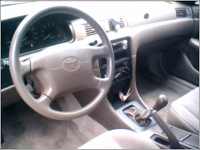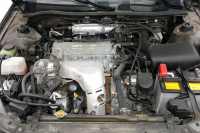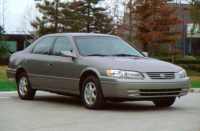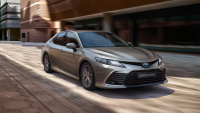The 1997 Toyota Camry passenger car was equipped with the body of the then-new generation XV20. The car was actively marketed in Australia, Oceania and North America. At the same time, Japanese buyers were offered a generation V40 Vista, which differed in body size and the list of engines.
A brief description of the 1997 Toyota Camry  The cars were equipped with a 4-door sedan body, designed to carry 5 passengers. For European and North American markets, the XV20 was offered with front-wheel drive, for Japanese customers the G-Four model with a four-wheel drive system with viscous clutch was available.
The cars were equipped with a 4-door sedan body, designed to carry 5 passengers. For European and North American markets, the XV20 was offered with front-wheel drive, for Japanese customers the G-Four model with a four-wheel drive system with viscous clutch was available.
The Vista variant was offered with either sedan or hardtop bodies (sold only through Toyota Vista Store dealerships). The car differed from the XV20 by the reduced size of the body, which corresponded to the preferential tax category under Japanese law.
Equipment and specifications
The V40 had a McPherson strut front suspension with anti-roll bar and anti-roll bar, and rear hubs were mounted on rubber wishbones. The brakes were hydraulic, with ventilated discs with floating brackets at the front and drums (with automatic clearance adjustment) or disks at the rear. Steering is rack and pinion type with hydraulic booster, for an extra cost the company offered 4WS (4 Wheel Steering) to improve maneuverability.
The base model had electric side window motors and instrument cluster with dial indicators. Improved models used Optitron combination with improved illumination of the scales. The steering wheel was made of polyurethane, and there were cars with a rim with wooden inserts on top and bottom. Some trucks had a glass sunroof with a curtain and electric drive. In addition to the radio, the trucks could be equipped with a laser disc player or navigation system with a color touch screen display.
The ventilation and heating system was equipped with separate ducts that supplied the air flow to the passengers in the rear row of seats. Some cars used an air ionizer located in the deflector in front of the driver's seat. The manufacturer offered electric adjustable front seats with memory position.
The finish of the door cards depends on the material used for the seat upholstery, and there are bottle pockets in the front overlays.
Technical parameters of the car generation V40 (model with front-wheel drive and a 2.2-liter engine, 1997 model year):
curb weight - 1450 kg;
allowable full weight - 1725 kg;
average fuel consumption (by the standard of Japan) - 10.2 km per 1 liter of fuel;
body length - 4800 mm;
width - 1785 mm;
height - 1420 mm
wheelbase - 2670 mm;
ground clearance - 145 mm.
Advantages and disadvantages
The advantages of the car, noted by the owners:
long life of the engine piston group (some instances have passed more than 600 thousand km without overhaul);
high quality of plastic and coating on decorative inserts;
roomy luggage compartment with the possibility to increase the capacity by partial or full folding of the rear sofa;
lever suspension does not transmit vibrations and shocks when driving on rough roads;
availability of cheap spare parts from alternative suppliers (the quality of parts is inferior to the original products).
Disadvantages indicated in the reviews and reviews:
The age of the car, which negatively affects the condition of the body;
increased fuel consumption due to the use of outdated automatic 4-speed gearboxes;
difficulties with acquiring new original spare parts;
large turning radius, making it difficult to maneuver in cramped conditions;
cracks on the windshield due to local overheating by the hot air flow from the heater (the problem is encountered in the northern regions);
leakage of engine oil along the joints due to natural aging of seals and gaskets (after overhaul the defect disappears).
Interior and exterior  The car received a stocky body with a reduced height of the hood and narrow headlamps with separate sections for low and high beam. The directional indicators and parking lights were installed on the front edge of the wings, and the side fender was equipped with orange-colored repeater. Along the front edge of the bumpers and side of the doors was a protective rubber pad, painted in body color and equipped with a decorative chrome strip.
The car received a stocky body with a reduced height of the hood and narrow headlamps with separate sections for low and high beam. The directional indicators and parking lights were installed on the front edge of the wings, and the side fender was equipped with orange-colored repeater. Along the front edge of the bumpers and side of the doors was a protective rubber pad, painted in body color and equipped with a decorative chrome strip.
The interior, with split front seats and a full 3-seat rear sofa, was trimmed in velour or leather, with height-adjustable headrests for all passengers. A center console with armrest was standard, and the instrument panel of foam plastic could be equipped with wood imitation inserts. A 1-zone climate control was standard. Steering wheel was adjustable in length and angle.
Car Engine
The cars used gasoline four-cylinder engines:
The base 1.8-liter 4S-FE with 125 hp (only offered in Japan);
The 140-horsepower 5S-FE with increased volume to 2163 cm³. Both engines had 16-valve heads with 2 camshafts, EFI system with electronic control was used for fuel supply. More expensive versions were equipped with a V-shaped 6-cylinder 2MZ-FE engine with working volume of 2496 cm3 and a power of 200 hp. There was also 2.2-liter supercharged 3C-T diesel engine with a 5-speed manual gearbox. For the US market, there was a version with a 3.0-liter V-shaped 6-cylinder 1MZ-FE engine.
Both engines had 16-valve heads with 2 camshafts, EFI system with electronic control was used for fuel supply. More expensive versions were equipped with a V-shaped 6-cylinder 2MZ-FE engine with working volume of 2496 cm3 and a power of 200 hp. There was also 2.2-liter supercharged 3C-T diesel engine with a 5-speed manual gearbox. For the US market, there was a version with a 3.0-liter V-shaped 6-cylinder 1MZ-FE engine.
For U.S. and Canadian buyers who opted for a Camry with the 3-liter engine, Toyota Racing Development offered a mechanically driven compressor. The supercharger system allowed for a boost of up to 247 horsepower with a simultaneous increase in torque, which peaked at a reduced crankshaft speed. Transmission was the same (4-speed automatic transmission without manual shift function).
Camry Safety
In the second half of the 1990s, driver and passenger safety requirements continued to tighten. Inflatable airbags for the driver and front passenger were standard equipment, and side-impact protection was provided by an alloy steel body cage. The braking system was equipped with ABS unit, which automatically distributed forces between the wheels. There were inertial type safety belts with pyrotechnic tensioners and height adjustable for driver and passenger.
The rear row was equipped with non-adjustable inertia belts for 3 passengers, and there were mountings for an additional child's seat. To protect the vehicle from fire, the fuel tank was stowed in a recess under the rear sofa (inside the wheelbase). The capacity of the tank on vehicles with front-wheel drive was 70 liters, on all-wheel drive versions the volume dropped by 5 liters due to a half-circular tunnel for the PTO line.


-rear-and-front-view-camera-6.png)

